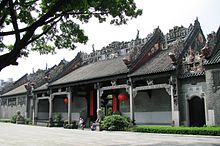Chen Clan Academy
| 陈家祠 | |

Entrance
|
|
| Established | 1894 |
|---|---|
| Location | Guangzhou, China |
| Type | Cultural |
| Chen Clan Ancestral Hall | |||||||||||
| Traditional Chinese | |||||||||||
|---|---|---|---|---|---|---|---|---|---|---|---|
| Simplified Chinese | |||||||||||
| Literal meaning | Chen Family Ancestral Hall | ||||||||||
|
|||||||||||
| Transcriptions | |
|---|---|
| Standard Mandarin | |
| Hanyu Pinyin | Chén Jiā Cí |
| Yue: Cantonese | |
| Jyutping | Chan4 Ga1 Chi4 |
| Guangdong Folk Art Museum | |||||||
| Simplified Chinese | |||||||
|---|---|---|---|---|---|---|---|
|
|||||||
| Transcriptions | |
|---|---|
| Standard Mandarin | |
| Hanyu Pinyin | Guǎngdōng Mínjiān Gōngyì Bówùguǎn |
The Chen Clan Ancestral Hall, also known by other names, is an academic temple in Guangzhou, China, built by the 72 Chen clans for their juniors' accommodation and preparation for the imperial examinations in 1894 in Qing Dynasty. Later it was changed to be the Chen Clan’s Industry College, and then middle schools afterward. Now it houses the Guangdong Folk Art Museum.
Located at Zhongshan 7th Road, the Chen Clan Ancestral Hall is a symmetric complex consist of 19 buildings with nine halls and six courtyards. Facing south, the complex forms around a north-south axis. A large collection of southern China art pieces, for example, wood carvings and pottery, can be found in the structure. The Chen Clan Ancestral Hall complex exemplifies traditional Chinese architecture and decoration style, and has influenced cultural and architectural developments worldwide. It was added in the list of "Cultural Relics of National Importance under the Protection of the State" in 1988.
From its former purpose, the Chen Clan Ancestral Hall is also known as the Chen Clan Academy. From the Cantonese pronunciation of the name, it is also known as the Chan Clan Ancestral Hall or Academy. Its Chinese name was formerly romanized as Chun-Ka-Che.
Chen Ruinan and Zhaonan, Cantonese returning from America, first proposed raising money from the various Chen lineages to build a temple for worship of their ancestors and an academy to train their clansmen for the imperial examination during the late Qing Dynasty. With money donated by Chens abroad and in 72 of Guangdong's counties, the hall was finished in 1894. When the imperial exam was abolished in 1905, the academy became a practical school for members of the clan.
...
Wikipedia
